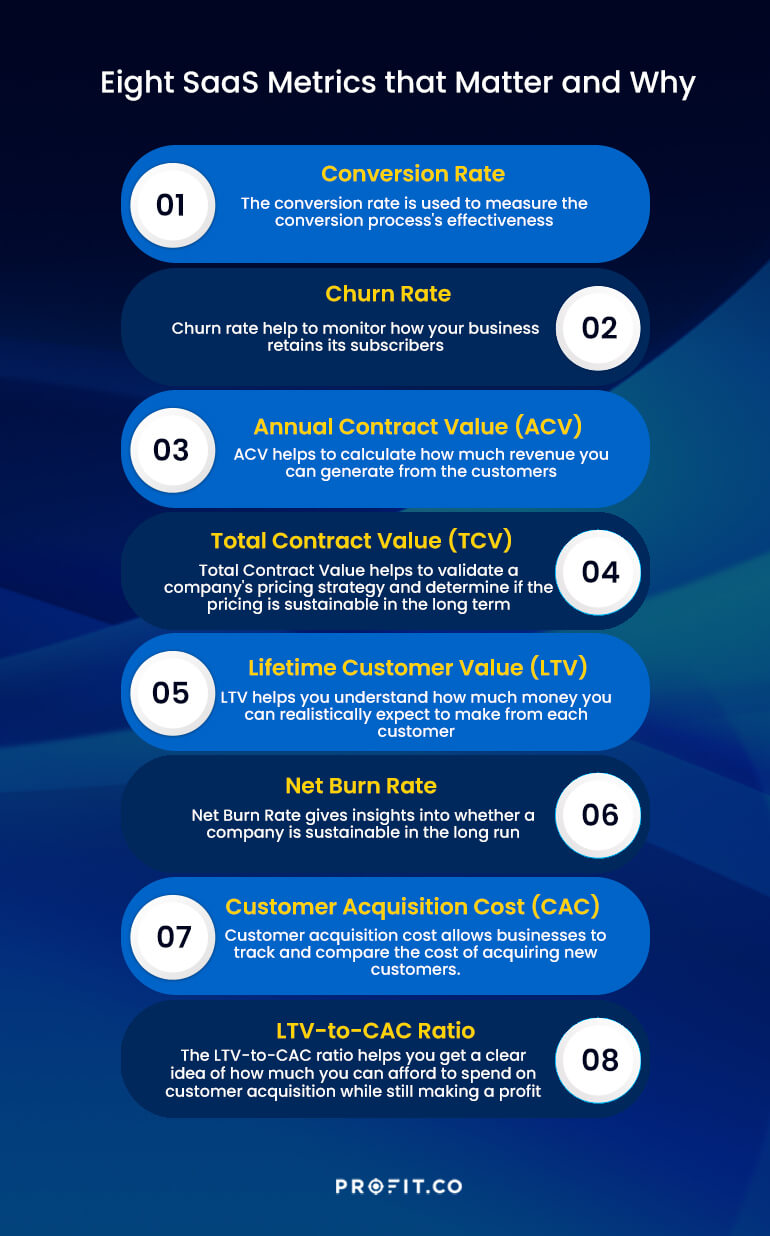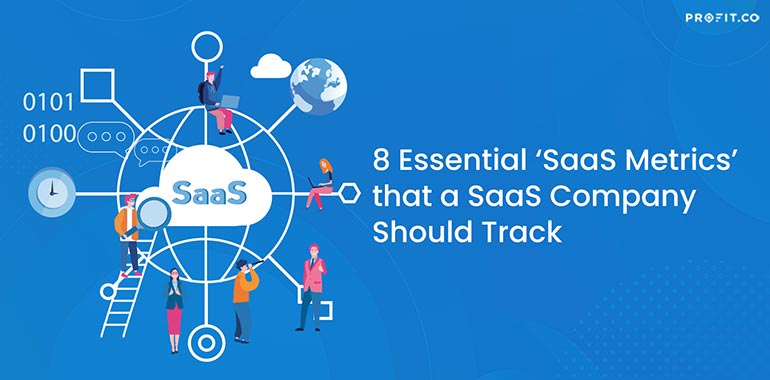In line with the nature of the constantly changing tech scenario, the way software businesses deliver their products and services and how they earn their revenues have changed drastically. The transformation of the tech scenario dominated by cloud based technologies has made it possible for companies to offer ‘Software as a Service’ (SaaS), which has led to the rise of the subscription model.
This significant drift in the business model has widened the scope for managing businesses, revenues and other business-critical parameters better. On the flip side, it presents a fresh set of challenges for a software business, as they cannot just complete the sale of a product, rest on their laurels and focus on something else. Businesses have to work hard to retain customers, by constantly delivering updates and new features in line with the trends. Keeping the business on a growth trajectory is far more difficult in a SaaS business model. That is why they need SaaS business metrics.
What is the SaaS model?
SaaS stands for software as a service. Unlike the other conventional software delivery models, where you have to make the complete payment to purchase a particular version of the software from a retail store or website and install it on a computer, in SaaS model, you can purchase a license for software that is hosted on a server and use it completely online instead of installing it on a computer.
In this model, you can pay for the software in monthly installments on an ongoing basis. Since the software is hosted on the cloud, the software company can constantly update it and make those improvements instantly available online to all users. The users get to access the latest features by paying a subscription fee rather than sticking to a fixed set of features specific to a particular version of the software. Through this model, customers can completely eliminate the cost of installing and maintaining their own IT infrastructure.
SaaS model – example
For example, if you are in need of enterprise software for customer relationship management, you can opt for a SaaS based customer relationship management suite such as Apptivo CRM that offers different plans for different types of businesses that operate at different scales. You can access the software from anywhere. In case you are scaling up your operations or if you need the features that are available only in the higher tier, you can upgrade the plan and instantly access the higher tier features from their servers on the internet. Another perfect example in the SaaS domain is the time tested OKR methodology which comes with many agile OKR tools for a seamless strategy execution. This model of payment and software distribution is called the SaaS model.
Metrics for SaaS companies
In the SaaS model, the upfront cost is low, as users split up the payments in monthly installments. On the flip side, they have an ongoing cost in the form of subscription fees as long as they keep using the software. From the software company’s point of view, the nature of the flow of revenue is completely different. So, in order to measure profitability, success and growth of the business in this SaaS model, and to make more accurate forecasts and projections, you need to keep track of completely different kinds of SaaS metrics that matter, which you may not have used in a more traditional software business.
If You Can’t Measure It, You Can’t Improve It
Are you looking for comprehensive goal management Software that allows you to track your performance? You can get started on Profit.co completely free today!
Following are the eight most important SaaS metrics that matter for a SaaS company.
1. Conversion Rate
2. Churn Rate
3. Annual Contract Value (ACV)
4. Total Contract Value (TCV)
5. Lifetime Customer Value (LTV)
6. Net Burn Rate
7. Customer Acquisition Cost (CAC)
8. LTV-to-CAC Ratio
SaaS Metrics that matter
1. Conversion Rate
Every type of business has unique conversion funnels, based on which they handle leads in different ways. For instance, an e-commerce site may collect the contact information of these leads for future communication, nurture them and feed them into the sales funnel. In SaaS businesses, the objective of this conversion funnel is usually to get the leads to sign up for a demo/free trial. Conversion rate is a SaaS metric used to measure this conversion process’s effectiveness. The conversion rate in SaaS can be classified into three different types depending on the nature of the conversion funnel. Conversion rate can mean the percentage of users who:
1. Among the total number of visitors of the site, signed up for a demo/trial.
For example, if your landing page had 10000 visits, and out of them, 2000 signed up for a free trial, then the conversion rate here would be (2000/10000) x 100 = 20%.
2. Signed up for a trial and then achieved activation, thus realizing the value and benefits of the product. For instance, if 2000 users signed up for a free trial and 1000 users started using the free trial version, then the conversion rate, in this case, would be (1000/2000) x 100 = 50%.
3. Signed up for a free trial and then got convinced to become a paying customer.
For instance, if 1000 users tried using the free trial version of the software and 200 users chose to buy a subscription to the software, then the conversion rate, would be (200/1000) x 100 = 20%.
It is crucial to calculate the conversion rate SaaS metric to identify the problems in the conversion funnel and address them.
2. Churn Rate
Since the SaaS model functions by collecting monthly subscription fees, it presents an opportunity for customers to stop using the software and opt out of the subscription when they want. This can have a significant impact on the company’s revenue. A SaaS business needs to constantly monitor relevant key metrics for SaaS and take measures to keep customers from opting out of its services. Churn rate is one of those SaaS business metrics that help to monitor how your business retains its subscribers.
- Churn rate helps you monitor the trends and determine why customers are canceling their subscriptions.
- It further helps you make accurate future revenue projections, as a low churn rate would mean you are not losing as many customers as you are gaining. Through this, you can ascertain the quality and strengths of your offerings, improve them based on feedback and you can set ambitious targets for the future.
- Finally, with the churn rate SaaS metric, you can benchmark your company against others in your industry.
Churn rate can be calculated by dividing the number of customers who canceled their subscription in a given period by the total number of customers you had at the beginning. For example,
If you started with 1000 customers at the beginning of the month, and you had only 900 customers by the end of the month, then Churn rate = 1000 – 900 remaining customers /1000 total customers in the beginning x 100 = 10%
i.e. 10% of your customers opted out of the subscription within a month.
3. Annual Contract Value (ACV)
Annual Contract Value is one of the most important metrics for SaaS businesses. ACV measures the total value of the contracts the company gets annually from the subscriptions. It also helps to calculate how much revenue you can generate from the customers.
ACV can be calculated using the following formula.
ACV = Total contract value (TCV) / Total number of years of contract. For instance, when a customer has a three year subscription/contract worth $30,000, then
ACV = $30,000/3 = $10,000.
In the SaaS model, the subscription fees are usually charged monthly. In that case, you can multiply the monthly subscription fees per month by 12. If the monthly subscription fee is $100, then
ACV = $100×12 = $1200
ACV excludes other upfront costs, such as setup and installation fees.
4. Total Contract Value (TCV)
Total Contract Value (TCV) is a key metric for SaaS that helps you measure the success of a SaaS business. TCV denotes the total value of all contracts a company has with its customers. TCV SaaS metric provides a projection of your company’s future revenue stream and helps forecast sales and growth. It also helps to validate a company’s pricing strategy and determine if the pricing is sustainable in the long term.
To calculate total contract value, you should add up all of the expected revenue from a customer throughout the subscription period, which includes the subscription fees and one-time costs, such as setup or installation fees. TCV also includes taxes.
The TCV formula is:
For example, if a company has 1000 customers, and each customer has an average contract/subscription value of $100, then
5. Lifetime Customer Value (LTV)
The lifetime value of a customer (LTV) is one of the key metrics for SaaS that helps you estimate the average customer spending. It is the total amount of money that a customer spends on average with your company throughout the subscription period. LTV can vary from customer to customer since it is an estimate. Everyone spends differently, opting for different subscription plans and subscription periods. So, the estimate will also change accordingly.
Several factors can impact LTV, such as customer churn. So it is crucial for businesses to regularly monitor and adjust their LTV calculation. LTV helps you understand how much money you can realistically expect to make from each customer. With LTV calculation, you can make more informed decisions about how to allocate/re-allocate their resources to maximize profitability and how much you can afford to spend on acquiring new customers and retaining existing ones.
The most common formula to calculate is:
For example,
- If the average order value is $100
- The average frequency in which subscription fees is paid is once per month, and
- The average customer lifespan is 3 years
Then the lifetime value of a customer = (100 x 12 months) x 3 years = $3600
6. Net Burn Rate
When running a SaaS business, you should be mindful of how you spend your resources because it takes resources to acquire new customers and retain them, in addition to the usual operating expenses of a business. So, at times you might be spending more than what you are earning, making losses temporarily. However, the money you are spending should lead to better results in the near future, such as bringing in more customers and revenue. If the amount spent is not bringing good results, then it can lead to a loss in the long run. So, you need to constantly monitor the net burn rate, which is one of the crucial SaaS metrics.
Net burn rate is the difference between the amount of money a company brings in per month in revenues and the amount of money it is spending. Net burn rate matters only when you are making less than what you are spending; if you are making more than what you spend, it will become profitable. Calculating the Net Burn Rate gives insights into whether a company is sustainable in the long run.
You can calculate the net burn rate by subtracting the total amount of money the company is spending in a month from the total revenue the company is bringing in during that month.
If your monthly revenue is $4000 and if you are spending $6000 in that month, then
7. Customer Acquisition Cost (CAC)
Customer acquisition cost is one of the top SaaS business metrics, and it is used to calculate how much it costs to acquire a new customer. Acquiring customers requires advertising, marketing spending, lead generation, lead nurturing and successfully achieving conversion after taking the leads through the sales funnel. All the costs involved in these processes constitute customer acquisition costs. Considering the fact that CAC is a cornerstone metric to be tracked in the SaaS platforms Organizations should have CAC KPI to track the progress periodically. Such a practice will help rectify and course correct the marketing and sale strategies of the Organization.
Customer acquisition cost allows businesses to track and compare the cost of acquiring new customers. By tracking CAC, you can verify the efficiency and effectiveness of your sales and marketing efforts. If your CAC is too high, you must cut spending and make your processes more effective.
You can calculate CAC by dividing the total marketing and sales expenses for a particular period by the number of new customers acquired during that same period.
If your sales and marketing expenditure per month is $5000 and the no. of customers acquired per month is 100, then
8. LTV-to-CAC Ratio
LTV-to-CAC ratio is among the important key metrics for SaaS. Customer Lifetime Value (LTV) denotes how much revenue a customer brings to your business during their lifetime. On the other hand, customer acquisition cost (CAC) shows how much it costs for your business to acquire a new customer.
The LTV-to-CAC ratio helps you get a clear idea of how much you can afford to spend on customer acquisition while still making a profit. A higher LTV-to-CAC ratio means that your business is generating more revenue from each customer, and as a result you can spend more to acquire new customers. A lower ratio indicates your business is not getting enough revenue from each customer to justify spending more on customer acquisition. In that case, you need to be more careful with your spending.
To calculate the LTV-to-CAC ratio, you have to divide the lifetime value of a customer by the cost of acquiring that customer. For example, if the LTV of a customer is $1,000 and if CAC spent to acquire him/her is $100, then LTV-to-CAC ratio is 10:1.

FAQs about SaaS
- What is the meaning of SaaS?
- What is a SaaS business?
- What are SaaS metrics?
SaaS stands for Software as a Service.
A SaaS business is one where the company offers software that can be availed and used online and paid for in the form of a monthly subscription fee.
SaaS metrics are the key business metrics that are used to keep track of the performance and profitability of a business that follows a subscription model for the sale of its software products.
Conclusion
You can measure numerous SaaS metrics, but some are more valuable to your business. When you monitor and analyze the most critical SaaS metrics, you’ll have actionable insights to ensure your future growth. Although calculations can be challenging, there are various tools you can use to measure performance. These key SaaS metrics show the success level of your current strategies and the areas that need work. To learn more about how Profit.co can help you focus, measure, and achieve your most important targets, schedule a free demo.

